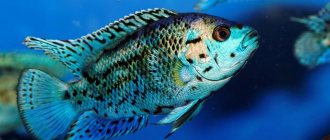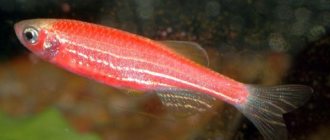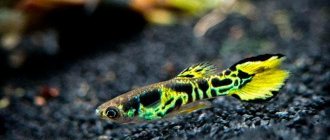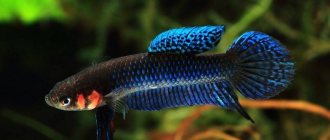Description
It reaches a length of 8–12 cm. The labyrinthine respiratory organ allows the animal to breathe air. Lives in bodies of water with low oxygen content, such as ponds, swamps and rice fields. Listed in the Red Book.
Appearance
The body of the macropod is oblong, flattened laterally. The fins are pointed, the long tail is forked. The fins on the abdomen are thread-like. The coloring is bright: blue and red stripes alternate on the body, the fins are also red-blue and shimmer in the light.
View this post on Instagram
Round tailed paradise fish#fish #fishtank #river fish #Macropodus ocellatus #biotope #aquariums #nature #layout #paradise fish
A post shared by SeungYoung Choi (@nark_choi) on Apr 10, 2021 at 7:13pm PDT
Behavior
Macropods have a difficult character. Males are very aggressive towards each other and other fish. Females are more tolerant of their tankmates. Good parents.
Lifespan
With good care, macropods live up to 8 years.
Kinds
There are several color forms and types of labyrinths. The maintenance and care of different types of macropods, as well as the conditions of compatibility, are identical.
Classical
The homeland of the classical macropod is China. The body is olive or brown. On the abdomen and in the head area there are blue spots with vertical brick-red stripes. The common macropod has different color options:
- Blue. At the back the color turns purple.
- Albino. The body of the macropod is white with yellow stripes and pink fins. The eyes are reddish.
- Red smooth. The body is brown, the head is blue. The fins are red, the stripes on the body are almost invisible.
Redback
Species described in 2002. Silver in color with reddish fins and back. The scales shimmer beautifully in the right lighting. The tail and dorsal fin are blue with a white edge.
Black
The fish is native to Vietnam, but previously it was believed that the black macropod lives in the waters of Indonesia. Color dark gray or brown. The tail of males is dark crimson. They are distinguished by a shy and more tolerant character.
Chinese
Second name: round-tailed. In captivity, it lives only 4 years. In winter, the Chinese macropod requires a decrease in temperature to 10–15 degrees. Susceptible to microbacteriosis (fish tuberculosis). Not common among Russian aquarists. With a classic macropod it produces hybrid sterile offspring with an inconspicuous color.
Types of macropods
There are several different macropods belonging to different subspecies, but only their color distinguishes them - the care and maintenance of the fish are identical:
- Classic (or ordinary)
Swims in China, can be of 5 different colors: with a brownish body, blue, white (albinos with red eyes), brick red and orange. - Black macropod
Became known in the first half of the 20th century, lives just south of the Mekong. But the body of the fish becomes black when it is active and restless, and when the individuals calm down and swim slowly, without reacting to anything or opposing anyone, the body becomes dark gray or brownish in color. The fins can also have different colors: reddish, bluish or pink. The black species is larger than usual and even more peaceful, but is more demanding of water temperature - the warmer it is, the better. Purebred dogs are unlikely to be found in markets and stores; they are not available for sale. Unless you order it from your place of residence. - Redbacks
They were first recorded in the early 2000s. Its body and fins have a reddish tint with a silver tint. Interestingly, under certain lighting the body becomes emerald. Its tail and dorsal fins are blue with white edging. Males of this species have longer and more voluminous fins. - Round-tailed macropods
Native to Korea, but also found in Taiwan and eastern China. Unfortunately, it lives in captivity for about 4 years, and Russian aquarists are unlikely to be able to boast of having this fish, because it requires special conditions: in winter, the water should not exceed +12-13°C, otherwise reproduction will stop. In addition, the fish are sickly - they often develop mycobacteriosis.
The color changes depending on where the macropod was born and lived, as well as in connection with the characteristics of care and feeding.
Content
Macropod is a fish suitable for a small aquarium. Hardy, able to live in extreme conditions.
Aquarium
One fish can be kept in an aquarium of 20 liters or more. For a couple of individuals you will need an aquarium of at least 40 liters. A lid is required, because macropods are prone to jumping out of the water. For each fish, create one large shelter on different sides of the aquarium, so the cohabitants will occupy their own territory.
Water parameters
| Temperature | 16–26 degrees |
| Acidity | 6–8 |
| Rigidity | 5–19 dGh |
| Water movement | weak or absent |
Change 20-25% of the fluid weekly. Do not allow fish to settle in unsettled water. Check the hydrochemical composition of water with tests.
Plants
Place floating and plants with strong root systems:
- hornwort;
- duckweed;
- Java moss;
- pistia;
- salvinia;
- Echinodorus;
- Vallisneria;
- Cryptocoryne.
Plants floating on the surface of the water should not block access to oxygen, so periodically thin out the greens.
Priming
Choose a dark substrate, because the macropod looks advantageous against a dark background. In addition, dark soil does not irritate fish. Boil the soil before placing it in the aquarium. Be careful with artificially colored stones. Dyes may be toxic. Clean the soil with a siphon once a week.
Equipment
Of the devices, a macropod needs a low-power filter that does not create strong water movement. A compressor and heater are not necessary, since the paradise fish is comfortable even at 18 degrees. Aeration of water is required if the aquarium contains other fish that are not adapted to breathe air.
Lighting
Select lighting based on the needs of aquarium plants. Bright light is undesirable. Turn off the lights at night; there should be no more than 12 hours of daylight. Do not allow sunlight to shine on the walls of the tank. Make sure that the lamps do not heat the water too much. Remember that incandescent lamps have the highest heat output.
All the subtleties of the content
Colorful paradise fish are not too demanding of their home environment. However, unscrupulous care of the aquarium will turn them into unattractive and sullen creatures. For good development and existence of macropods, comfortable conditions must be created:
- The minimum volume of water container for two adults should be at least 20 liters, the optimal option is 40 liters. Small vessels can be used as a full-fledged home for chordates. However, you should not count on adult males and females reaching full standard size. The top cover or glass should not be too tight, since macropods often breathe air on the surface. The optimal distance from the water surface to the lid is 5 cm.
- The aquatic environment warms up to 20-25 degrees, its acidity is from 6.5 to 8. Water for paradise fish living without neighbors does not need filtration or aeration. But if the filter is installed, strong currents are definitely excluded. It is recommended to carry out a 20% change once a week.
Water for macropods should warm up to 20-25 degrees. - The brightness of the lighting should ensure sufficient growth of the green spaces that decorate the home aquarium. The optimal soil for Macropodus will be crushed pebbles, gravel, coarse sand, and expanded clay. It is recommended to select dark types of soil, the thickness of which starts from 5 cm.
- Planted in large quantities, labyrinthine algae and aquatic grass have a positive effect. For planting in the ground, it is recommended to use hornwort, vallisneria, and pinnate. On the surface of the water surface it is appropriate to place pistia, riccia, nymphea, and ordinary duckweed. Females are in dire need of natural shelters during the spawning period, when the male shows aggression. Grottoes and all kinds of driftwood are often used as decoration. The best options are those that act as shelter.
Useful feeding tips
Macropods living in natural conditions are omnivorous. But preference is given to animal food. As for home conditions, the fish diet should contain the following components:
- coretra, tubifex, live bloodworm;
- dry food in the form of granules, flakes; to maintain the bright color of underwater pets, it is recommended to use ready-made substances based on carotene;
- larvae of bloodworms, cyclops, black mosquito, daphnia, frozen moina, crushed shrimp, which are warmed to room temperature before feeding;
- Occasionally, homemade minced meat based on seafood is introduced into the diet.
Feeding is carried out no more than 2 times a day and in small portions, this prevents pets from overeating.
Aquarists often call the paradise fish the orderly. She happily eats hydras and planarians, and easily copes with snails that reproduce uncontrollably. Crustaceans are also eaten, so cohabitation with shrimp will lead to the death of the latter.
Macropods should be fed no more than 2 times a day to avoid overeating.
Feeding
The macropod prefers a meat diet. A balanced diet contains:
- dry food for cockerels and gourami;
- daphnia;
- tubifex;
- bloodworm;
- black mosquito larvae;
- coretra;
- Artemia;
- cyclops;
- shrimps.
Provide a varied diet 1-2 times a day. Paradise fish are prone to overeating; measure portions carefully and remove excess food in a timely manner. Treat live food in a solution of methylene blue or potassium permanganate.
Macropod breeding
Breeding this type of fish is not difficult. Before spawning, spawners are kept in separate aquariums and fed generously with ice cream or live food a couple of times a day. A female ready for spawning will have a rounded abdomen. Under no circumstances should a mother who is not ready for spawning be placed with a male. The male will begin to chase her and may injure or kill her.
A container with a volume of 50 liters or more is suitable as a spawning tank. It contains 15-20 cm of water with the same hardness and acidity parameters as in a general aquarium. The water temperature is increased to 26-29 degrees. You can install a small filter in the spawning tank. But the current should be small.
A lot of hornwort is placed in the spawning tank so that, if necessary, the female can hide in it. To build a nest, the male needs floating plants, such as duckweed or riccia. When the nest is built, the male will drive the female towards it. He will begin to hug and squeeze her, squeezing her calf. Once the eggs are laid, the tired female will sink to the bottom. In one spawning you can get about 500 eggs. The eggs are lighter than water, so they will float and stay in the nest. The male will return the fallen eggs to their place.
At the end of spawning, the female is removed from the spawning area, and the male is left to guard the eggs. If you do not remove the female, the male will see her as a threat to the eggs and will kill the female. As soon as the fry hatch, the male is also removed from the spawning area. The hatching time of the larvae depends on the water temperature. The higher it is, the faster this will happen. The babies are fed ciliates or dry food ground into dust.
Compatibility
Optimally paired or kept in a harem of a male and several females. It is acceptable to keep with other non-aggressive and non-slow species if the fish grew up together:
- large zebrafish;
- peaceful barbs (black, gold, green);
- tetras;
- corridors;
- ancistrus;
- peaceful gourami (pearl, platinum);
- Lalius.
Compatibility with macropods is achieved in large aquariums that take into account the needs and characteristics of each species.
Do not place the macropod in an aquarium with small or stubborn fish, fry, or species that require different water parameters:
- goldfish;
- guppy;
- neon;
- nothobranchius;
- small or snooty barbs (Sumatran, cherry)
- cichlids;
- piranhas.
Maintenance and care
Unassuming macropod fish are an excellent choice for the beginning aquarist, if kept with large fish or all alone. They are absolutely undemanding to water temperature and can live in an aquarium without additional heating. Macropods are quite harmonious with neighbors of similar size.
Aquarium
For comfortable keeping of macropods, it is advisable to purchase an aquarium with a capacity of 30-40 liters. You should not rely on the fact that in aquarium conditions macropods will develop to their actual size. The outer lid or aquarium glass should not be too close to the aquarium, since macropods require oxygen. A comfortable distance from the aquarium lid to the water surface is 5 cm.
Aquarium with macropods
Comfortable water indicators for successful maintenance of macropods:
- Optimum temperature – 15-26 °C;
- Acidity level – 6.0-8.0;
- Water hardness level – 6-20.
On a note. It is recommended to add Tetra ToruMin - a useful natural conditioner with natural peat extract, which gives the water a natural brownish tint. 1/3 of the aquatic environment in the aquarium is changed weekly.
Equipment
As for the internal equipment of the aquarium, the installation of a thermostat and compressor is optional. Lamps inside the aquarium provide normal conditions for the growth and development of ground algae. To maintain a comfortable environment in the aquarium, installing a filter is mandatory. At the same time, there is no need to create a strong current; macropods feel comfortable in a calm water current.
Light
Macropods love the dim light that aquarium plants provide them. The light from the lamps installed inside, falling on the plants, becomes muted. Plants need good lighting. For macropods, a lamp with a scattering beam is suitable; it is advisable to turn off the light at night.
Priming
For comfortable maintenance of labyrinths, it is advisable to use dark-colored soil, against which they look even more attractive. Coarse sand, small sifted pebbles, street gravel or expanded clay are suitable as soil. The total layer thickness should be 5 cm or higher.
Plants and decor
Any common plant species will be excellent decorations for labyrinths: vallisneria, hygrophila, unpretentious ferns, lush hornwort, aquarium mosses, echinodorus. Macropods feel great in the company of such floating representatives of the green world as pistias and unpretentious riccias.
Vallisneria for maintaining macropods
Females require natural shelters during spawning, when the male’s aggression is off the charts. Grottoes and all kinds of driftwood are great for decoration. Any type of decor that can serve as a refuge will do.
Reproduction
Labyrinth fish are easy to breed in an aquarium. Prepare the spawning tank:
- Raise the temperature to 26–28 degrees. The temperature change should be smooth.
- Acidify the water so that the pH shifts to 6. This can be done using chemicals, marble chips or peat.
- Set the water level to 20 cm.
- Place more shelters in the spawning area for the female: plant bushes or grottoes. Macropods spawn better with floating plants, which makes it easier for labyrinths to build a nest.
Before breeding, feed macropods with meat food. Please note that males become very aggressive towards females during the breeding season.
Sex differences
Distinguish a male from a female by the following characteristics:
- the body of males is a couple of centimeters longer and slimmer;
- the color is more saturated than that of the female;
- the fins are long and pointed, in the female they are more rounded and shortened.
Spawning
The male builds a nest from air bubbles and plant particles at the surface of the water. During this period, remove the females, as the male can injure them. Once the spawning nest is complete, return the females to the aquarium to spawn the eggs. The male will collect the eggs in the nest and take care of the offspring until hatching.
It is better to plant the females again. One female produces up to 500 eggs. The incubation period lasts 3–5 days. Parental instincts are abandoned by the male after the fry hatch. To preserve the offspring, place the parents and fry in separate tanks. Feed the young:
- Artemia nauplii;
- ciliates;
- microworm;
- boiled egg yolk.
Compatibility with other fish
The macropod is very interesting to watch. He is smart and curious. Treats his own kind aggressively. Therefore, adult males are never placed in the same aquarium. They will fight to the death in it. If plants and other shelters are available, the male can be kept with the female. Several females can live in one container.
Large and non-aggressive fish will be good neighbors for macropods: barbs, copper tetras, synodontis, ancistrus catfish, acanthophthalmus. Fish with veil fins, such as veil speckled catfish or guppies, will be skinned.
Diseases
Labyrinth fish are disease resistant. In unsuitable conditions people get sick:
- Ichthyophthyriasis. The disease is accompanied by white dots on the body. It is treated by fever using special medications or quinine hydrochloride.
- Tuberculosis. Fish in an aquarium with poor hygiene are susceptible to the disease. The disease is rarely treated.
- Parasitic diseases. Parasites such as nematodes or carp lice enter the aquarium through poorly processed food, soil or plants. You can rid your fish of parasites with special preparations, a solution of potassium permanganate or food mixed with piperazine.
- Fin rot. The fins of the diseased individual are destroyed. The disease is treated with malachite green or antibiotics.
Reviews
Beginning aquarists, as well as hobbyists, get this fish. It is interesting to watch the inhabitant of the aquarium during spawning. There are specimens on sale with a less pronounced color, which is a consequence of crossing representatives of different species.











